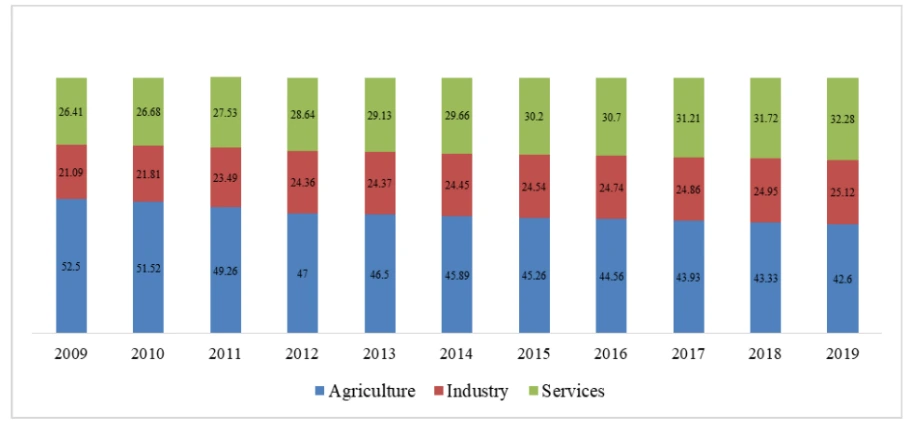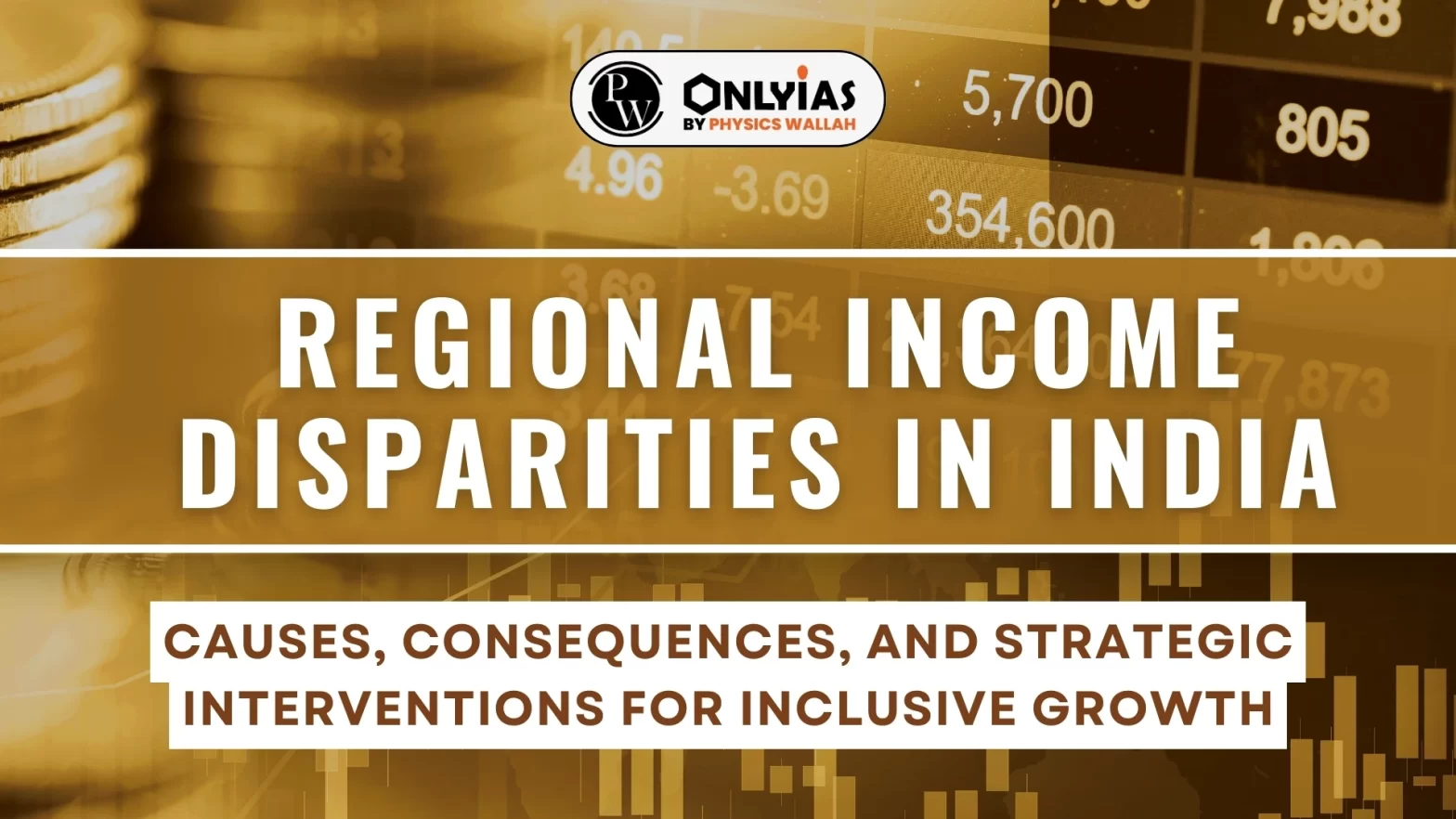Context:
This editorial is based on the news “The geography of unequal growth” which was published in The hindu. The income Disparities in India’s states over the past three decades have increased significantly.
Geographical income Disparities in India’s Economic Landscape: A Tale of Rising Income Gaps Across States
-
Geographical Divide of SDP:
- A clear geographical distinction exists between states with per capita State Domestic Product (SDP) above the national average in 2019-20 and those below it.
- The affluent states are situated in the south, west, and northwest, while the less prosperous ones are in the north, center, and east (refer to the map).
- During 1990-91, the per capita State Domestic Product (SDP) of the higher-income states was 1.7 times that of the lower-income states which increased to 2.5 times by 2019-20.
-
Prominent Distinction of SDP in the Manufacturing and Services Sector:
- In manufacturing, the higher- to lower-income states’ per capita SDP ratio increased from 2.4 in 1990-91 to 3.6 in 2019-20.
- Similarly, the services sector rose from 2.0 to 2.9 over the same period.
| State Domestic Product: The State Domestic Product is defined as the aggregate of the economic value of all goods and services produced within the State’s geographical boundaries, counted without duplication during a specified period, usually a year. |
Exploring the Multifaceted Causes of Regional Income Disparities in India’s Economic Landscape

-
Historical Factors
- The British rulers and industrialists developed only those regions in India that possessed rich potential for prosperous manufacturing and trading activities.
- Ex-Maharashtra and three metropolitan cities like Kolkata, Mumbai and Chennai.
-
Failure of Planning Mechanism:
- The planning mechanisms enlarged the disparity between India’s developed and less developed states.
- Punjab and Haryana received the highest per capita plan outlay from the First to the Seventh Plan. States like Gujarat, Maharashtra and Madhya Pradesh also received larger plan outlays in almost all the five-year plans.
- On the other hand, the backward states received the smallest allocation of per capita plan outlay in almost all the plans.
-
Lack of Growth of Ancillary Industries in Backward States:
- The Government followed a decentralized approach for the development of backward regions, establishing public sector industrial enterprises in backward areas like Rourkela, Barauni, Bhilai, Bongaigaon etc.
- However, due to lack of growth of ancillary industries in these areas, all these areas remained backward in spite of huge investment made by the government.
-
Failure of India’s Industrialization Strategy:
-
- Unlike China, India could not break its stagnant history of industrialization. Instead, the services sector emerged as the driver of economic growth.
- The inability of the industry and services sector to generate sufficient jobs for people migrating from agriculture is another reason for this disparity.
- Between 2012 and 2019, there has not been a 1 percentage point increase in the workforce employed in the industry sector.
-
Concentration of Services Sector in High-Income States:
-
- A major source of growth in the post-liberalisation era has come from services, particularly information-technology companies. which account for 7.4 percent of gross domestic product and employ 5.4 million people.
- They are almost entirely located in the few higher-income states with West Bengal (Kolkata) as an exception.
- Recently, some cities have emerged as information technology (infotech) hubs in states with lower growth rates. Ex-Jaipur, Indore, Bhopal, and Bhubaneswar.
- However, no such developments have been observed in the northern states.
-
Declining Public Investments:
- The primary factor contributing to the expanding disparity in per capita State Domestic Product (SDP) is the increased shift in investment from the public to the private sector during the post-1991 liberalization era.
- Between 1990-91 and 2019-20, the public sector’s share in gross fixed capital formation has declined from 40 percent to 23 percent, while the private sector’s share has increased from 18 percent to 38 percent.
- Consequently, the highly imbalanced distribution of significant entrepreneurial capacity in large enterprises within the private sector stands out as the most crucial reason for the widening gap in per capita income between the north, center, and east, on the one hand, and the south, west, and northwest, on the other.
-
Poor Linkage of Economic Hubs:
- India’s growth hubs are not connected with each other, either geographically or via a particular engine of growth.
- The few growth hubs in India did not lead to spillover effects leading to skewed distribution of employment across the states creating pockets of poverty in the poorer states.
- Poor States are employed in some forms of agricultural activity. However, their contribution to the national GDP is minimal.
- With no growth engine, there is no economic mechanism by which these states can connect and benefit from a spillover effect.
- Ex-Uttar Pradesh (north, sub-Himalayan), Rajasthan (far-west, desert), Madhya Pradesh (center, arid plateau), Bihar and Orissa (contiguous states in the north-east) and sub-Himalayan states in the far-east.
-
Limited Success of Green Revolution (GR):
- The benefits of the GR have been unevenly distributed, with some regions benefiting more than others.
- The benefits were concentrated in Punjab, Haryana and Western UP regions, creating economic and social disparities among regions.
-
Economic Disparities: Socio-Economic Inequities in India’s Development Landscape:
-
- Labour Force Disparity: In northern and central states, the urban labour force participation rate and the percentage of workers with regular wage/salary income are below the national average.
- Disparity in Access to Engineering Education: About 70 percent of the engineering seats are in higher-income states.
- Poor Investment in Education: Health spending has increased from 4.5 percent to 6.6 percent, and the spending in education has decreased (from 10.8 percent to 9.7 percent).
- Entrepreneurship Imbalance: According to the Annual Survey of Industries (ASI) 2019-20, higher-income states accounted for approximately 75 percent of the number of factories, fixed capital, and employment.
- 87 out of the wealthiest 100 Indians reside in high-growth states.
Impact of Unequal Growth: The asymmetric growth resulted in a concentration of industries in select pockets, resulting in
- It impacts households’ access to basic services such as health, nutrition, and physical infrastructure
- highly skewed population distribution
- Overcrowded cities
- Migration of poor to urban areas
- The increase in slums
- The rise in the cost of urban housing
- Quality-of-life issues such as water table depletion and air pollution.
Government Initiatives for Regional Development and Reducing Disparities in India
- Income Distance weightage in 14th Finance Commission: The commission assigned 50% weight to income distance as it is the only measure of fiscal capacity.
- Income distance is the distance of a state’s income from the state with the highest income.
- Backward Regions Grant Fund Scheme: It is designed to redress regional imbalances in development. The fund will provide financial resources for supplementing and converging existing developmental inflows into identified districts.
- B.D. Pande Committee 1968: To suggest a strategy to minimize regional imbalances by establishing industries of all sizes in selected backward areas or regions through financial and fiscal incentives.
- Niranjan Nath Wanchoo Committee, 1968: It was appointed by the National Development Council to conduct a careful study on regional imbalance.
- Sukhamoy Chakravorty, 1972: A Committee on Classification and Identification of Backward areas.
|
- Rashtriya Sam Vikas Yojana (RSVY): The Scheme aimed at focused development programs for backward areas, which would help reduce imbalances and speed up development.
- Aspirational Districts Programme (ADP): It aims to transform the 112 most under-developed districts nationwide.
- National Rural Livelihoods Mission (NRLM): It aims to promote poverty reduction by building strong institutions for the poor, particularly women, and enabling these institutions to access a range of financial services and livelihoods.
Way Forward: Strategies for Bridging Economic Disparities in India
- Connecting Value Chains in High-Income States with Low-Income States: Entrepreneurship and labor skills in lower-income states need to be promoted along with connecting these regions with higher-income states.
- At present, the national value chains in industries like vehicle manufacturing are more or less confined to the higher-income states.
- Hence, a national policy that promotes value chains that link enterprises in southern and western states with lower-cost opportunities for input supply or assembly operations in northern and eastern states is needed.
- This will require measures to encourage the expansion of medium and small enterprises, which are present in large numbers in lower-income states.
- Skill Development: Immediate actions are required to enhance skill development and engineering education.
- This will cultivate the potential necessary to attract enterprises from higher-income states that have either already surpassed or are on the verge of reaching a stage where their share in the working-age population is no longer increasing.
- Region-specific interventions: A one-size-fits-all approach is unsuitable for a diverse country like India.
- It needs a focus on dimensions such as setting up agro-processing storage unit storage and transportation and generating accessible employment opportunities supplemented by significant investments in education and health.
- Relaxing Borrowing Limits for Poor States: The country’s Poorer states require a long-term fiscal stimulus to catch up with the rest of the country.
-
- The central government may reduce its borrowing and debt limits to facilitate more liberal borrowing limits for poor state governments.
- This will enable poorer states to raise their capex spending, raising growth, and helping them catch up with other states.
- Increasing Female Labour Force Participation Rate: The female labor force must be empowered to increase their participation rate.
- According to the Periodic Labour Force Survey Report 2022-23, India’s Female Labour Force Participation Rate stands at 37.0% in 2023.
Conclusion
The issue of regional development disparity must be given prime importance as 75 percent of the medium-term and 90 percent of long-term growth in the working-age population will occur in these states. If we fail to boost these states’ income and growth potential, India’s demographic dividend will become a demographic downfall, which could worsen political instability.
News Source: Business Standard


